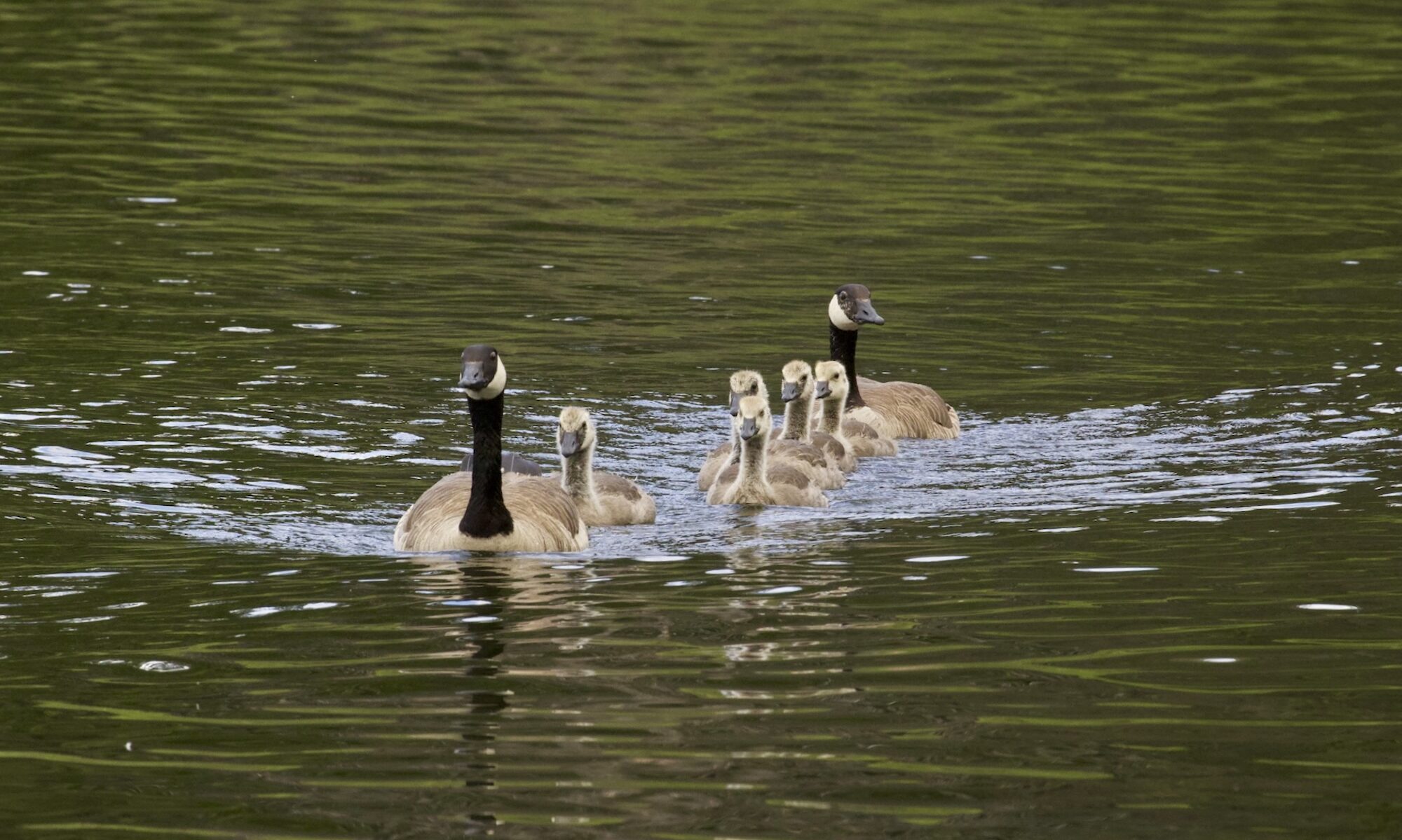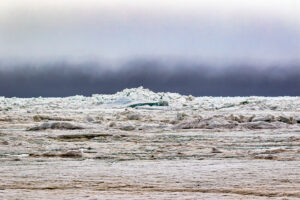
Reflecting on what part of this final leg of the Alaskan journey was most memorable, I’d say it was the expansive barrenness; an ice-covered Bering Sea meeting textured tundra plains that culminate into endless miles of rounded hills with smatterings of snow everywhere. After wonderful visits in Unalaska (Dutch Harbor) and Nome, both of which are featured in this blog, we closed out our journey with visits to Bethel, Barrow, Anchorage, and Seward.
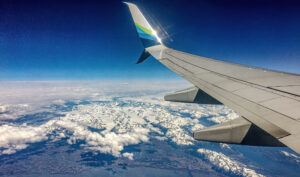
Anchorage, a beautiful city embraced by the stunning Chucach Mountains, was our inaugural stop in this nearly 4-week journey. As Alaska Airlines Fight 94 made its approach, our route gave us magnificent views of the Copper River delta and Wrangell – St. Elias National Park in the distance. On our 2016 road trip to Alaska, we gave this park our best shot but inclement weather shut us down; it dumped on us and the massive peaks were smothered in gray. This visit featured a sparkling afternoon, the warm light highlighting glaciers that meander through miles-wide drainages before sliding imperceptibly to the shimmering Prince Edward Straits. Our captain flew us surprisingly close to craggy peaks, some scarred by avalanches on the otherwise glimmering snow.
Anchorage was hub on several flights during the visit, and we got to know the car rental facility well. Both pick-up and drops were seamless and our planning in advance, both with Costco Travel and agencies paid off literally in the quality of the vehicle and the price. On one occasion, we shortened our stay in Bethel by a couple days and a $70 1-day overnight rental booked in December ballooned into a $470 3-day contract. And we were lucky to get that! With travelers feeling unrestrained by the year-long grip of COVID-19, there was a run on rental cars parallel to none the agents could recall. NO reservations were available anywhere; we got lucky on a last minute cancellation (and paid dearly for it).

Our objective was getting close to the birds, not visiting big cities. After replenishing our supplies, we departed for Bethel, a town of 6,500 that is the largest community on the Kuskokwim River, located approximately 50 mi upriver from where the river flows into Kuskokwim Bay. A number of factors dimmed our appreciation of the visit (one being the cancellation of a float plain flight into a remote lodge up river), but adhering to plan we were on a boat first thing the morning after our arrival. John McDonald and and his wife, Bev, a lifetime resident of Bethel, sped us several miles upriver to the confluence of the Kuskokwim and Gweek River, which is really a tiny section of the enormous Yukon Delta National Wildlife Area. In addition to years of guiding anglers, they were familiar with local birds. John navigated his comfortable aluminum boat along waterways that in winter literally become highways for natives living in remote villages. In trucks or snow machines on 5’ thick ice, they follow the same route as we were in his boat—only farther. Following break-up in mid-May, supplies purchased in Bethel are boated into villages using skiffs powered by “evinrudes” (the generic name for outboard engines). Pickups are left parked along the shore of the marina as if beached vessels themselves. Our expectations of Bethel were of exotic birds on every fencepost and willows blossoming with bird treats lining the shores. One constant was the beautiful song of the Gray-cheeked Thrush each morning outside our Air BnB. Otherwise the birding was underwhelming and, lest I forget, we experienced our first mosquitoes while trudging in squishy tundra looking for an Osprey nest and the occasional Moose. We found them and they found us. Thank heaven for our bug hats!
Earlier than planned, we decided to bail on Bethel. Another lesson we learned about spontaneity has to do with the airlines. We’d booked most of our AlaskaAir flights using miles with the understanding there’d be no changing fees. That’s absolutely true, so imagine my surprise when the cost of the same flight 2 days earlier than scheduled was double for what I’d booked it several months ago. Clearly the single most important item in our personal inventory were our phones. The 5 days in Unalaska without the Internet or cell service was manageable. Even if we’d experienced car trouble on some remote road, there was a Native Corporation Security person regularly plying all the roads of their nation making sure tourists had the necessary permits (we did). So with our Bethel plans in limbo, several of us were communicating concurrently—airlines, Anchorage accommodations, shuttles, Bethel transport—and our slightly longer visit to Anchorage resulted in longer visits to Potter’s Marsh and other birdy spots we’d hoped to explore.

I can’t over emphasize how blessed we were having Terry and Marty as traveling companions, and that’s a verb I use sparingly. Regardless of the inevitable complications that arise with a journey of this nature, they quickly were resolved and we calmly resumed our shared fascination of nature and relished each other’s company to the fullest.
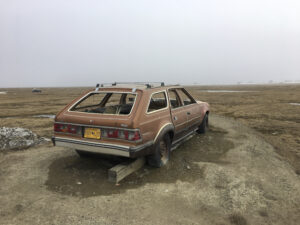
With the river speedboat ride behind us, we shifted gears and amped up for a flight to well above the Arctic Circle. We checked our bags, dropped off the rental car, and excitedly boarded AlaskaAir for our journey to the northernmost city in the United States. In 2016, the town of Barrow officially restored its original name to Utqiagvik (oot—kay-ahg—vik), and by the end of our 3-day visit that was the extent of our Inupiaq vocabulary. Only it was supposed to be a 4-day visit.
As we approached our destination, our sunny view of the seemingly endless pond-covered tundra disappeared by fog. The plane’s seatbelt sign went on, the landing gear was locked into place and the engines faded into that familiar drone that varies as your ears decompress. Suddenly, the captain powered the engines into full-speed-ahead and the nose of the aircraft lifted up, up, and out of the dense fog. We thought that perhaps he’d missed the runway and was swinging around for another shot. Sadly, it was announced that the pilot aborted the landing due to the lack of visibility on the ground. You can only do so much with a radar landing, and there’s no substitute for safety—or hitting a rogue Polar Bear. So back to Anchorage we flew, cocktails thankfully on the crew, and again our phones bailed us out.
We found accommodations and dined on the porch of the LakeShore Lodge located right on the watery landing strip of Lake Hood Floatplane Base, with nearly 200 daily operations has become the largest and busiest aerodrome in the world. Mostly single-engine planes motored by us, one after the other, and then accelerated on floats until lifting off into the clouds. Arrivals were far more subtle, and it seemed every other person on that porch was either a pilot or a wannabe. Conversations at tables near us were all about the intricacies of taking off and landing on water. The most salient point was that when taxiing to your dock, float planes don’t have brakes (or reverse). I’d be a mess.
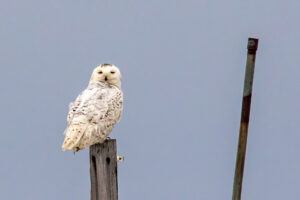
The following day, we knew the drill and gratefully landed without fanfare. With a road system reminiscent of Nome but lacking any of its charm, we drove on and on until our journey became impassable due to washouts, ponds, or snowplow embankments. Our 2-hour guide on day one advised us to pay special attention to every tower, power pole, and house chimney in our quest for the 2-foot-tall Snowy Owls. One of our target birds, we saw several; the male a shiny white whereas the female has some dark streaks. A surprise was seeing a couple Short-eared Owls and, of course, 2 species of Eiders (the Common and Spectacled). One evening, well past dinner and still bright, we revisited a former route only to find it impassable due to a washout. Unfazed, your intrepid adventurers braced the freezing weather and continued on foot (I again grateful for my latex neoprene footwear and REI wool socks). If your goal is to stay dry, remain standing, and be comfortable and warm in your rubbers, Xtratuf boots are definitely worth it. The fact I wore mine nearly every day is a firm endorsement (I did change my socks periodically). No mosquitoes there, for sure.
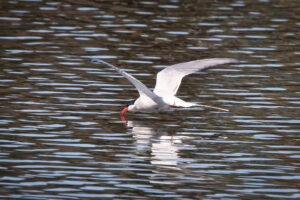
Our trip winding down, we spent a final night in Anchorage, and dined well. Alaska is expensive, and food costs bore the brunt of that reality. With us being foodies, we simply enjoyed our meals, our beverages, and brightened things up occasionally with a tasty homemade meal. Each visit to Anchorage usually included a stop at Winchester Lagoon, a favorite nesting place for Arctic Terns and right on the Tony Knowles Bike Path. It runs 11 miles and follows the shore of Cook Inlet from downtown Anchorage to Kincaid Park, most of the shoreline a protected Wildlife Area. We spied a copper-color colored Sandhill Cranes not far away learned that they dust themselves to blend into the environment for protection—as if a bird that size could hide in a miles-long mud flat at low tied.
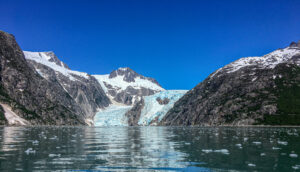
Following that 2016 disappointment at Wrangell-St. Elias National Park, we’d taken the Alaska Marine Ferry from Valdez to Seward (via Whittier, its port). The ferry system no longer stops in Seward, deferring to their grotesque cruise kin. After a year of no cruise ships bringing in long-needed revenue, Seward is beginning to flourish; albeit with road and rail traffic. Our brief visit focused on a day on the water with Capt. John Maniscalco, a marine biologist specializing in Stellar’s Sea Lions who splits his time at the Alaska SeaLife Center in Seward’s old town (when he’s not working on his 27’ boat, the Jack Sparrow). He owns Alaska Seabird Charters, and we fortunately had calm waters most of the day, motoring through Resurrection Bay to the Chiswell Islands. From there, we headed west to Northwestern Fjord and lunched amidst small icebergs calved off the enormous Northwestern Glacier. Needing more ice for the cooler, he simply hauled in a basketball-sized piece with his fishing net.
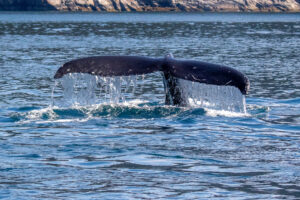
While he expressed concern for the diminishing numbers of Rhinoceros Auklets, he had plenty of other species up his yardarm: Parakeet Auklets, Red-faced Cormorants and Puffins of both species lurking in rock crevices and in an auspicious location called Honeycomb Cave. We were unable to enter the large, dark sea cave, but with binoculars could see the cormorants—a nesting pair. Near Fox Island on our choppy return to port, we saw our third whale species of the day. Earlier we’d seen both Fin and Orca whales from a relative distance. So as not to disappoint, John and his trained Humpback entertained us for 15 minutes, no more than a couple hundred feet from our boat. The whale was clearly not threatened by us and rose several times for air—deep inhalations a yoga teacher would approve. At one point Capt. John excitedly said, “She’s diving!” He’d observed a slightly steeper roll and predictably her tail rose grandly for a moment, dripping frothy seawater, before powering the massive mammal to the bottom. Combined with the Steller’s Sea Lions, some Harbor Seals, Dal’s Porpoises and a Sea Otter, we had a 7-mammal day in addition to a knowledgeable captain. It was a great party and fitting closures of a wonderful trip with dear friends (you’ve gotta be to spend that much time together).
“Lifer” birds seen in Alaska (some even have photos):
Brant Goose, Long-tailed Duck, 4 species of Eiders (Common, King, Spectacled and Steller’s), Black Scoter, Rock Ptarmigan, Pacific Golden Plover, American Golden Plover, Bristled-thighed Curlew, Bar-tailed Godwit, Hudsonian Godwit, Red Knot, Pectoral Sandpiper, Semipalmated Sandpiper, Red Phalarope, Sabine’s Gull, Aleutian Tern, Parasitic Jaeger, Pomarine Jaeger, Thick-billed Murre, Ancient Murrelet, Parakeet Auklet, Snowy Owl, Gyrfalcon, Alder Flycatcher, Lapland Longspur, Blackpoll Warbler, Hoary Redpoll, Gray-crowned Rosy Finch, Snow Bunting, and a Bluethroat.
Photo Galleries (Captioned collections comprising our nearly 4-week adventure)
